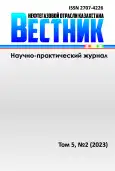Study of the pore structure and calculation of macroscopic characteristics of rocks based on X-ray microcomputed tomography images
- Authors: Bolysbek D.A.1,2, Kulzhabekov A.B.2, Bekbau B.Y.1, Uzbekaliyev K.S.1
-
Affiliations:
- Satbayev University
- Al-Farabi Kazakh National University
- Issue: Vol 5, No 2 (2023)
- Pages: 17-30
- Section: Geology
- URL: https://bakhtiniada.ru/2707-4226/article/view/250541
- DOI: https://doi.org/10.54859/kjogi108647
- ID: 250541
Cite item
Full Text
Abstract
Background: Absolute and relative phase permeability and capillary pressure are important parameters in predicting oil and gas production from reservoirs, especially when acidizing the bottomhole zone of a well. They are mainly determined during long and resource-intensive laboratory experiments. Thus, additional approaches are required for the operational determination of the above parameters. The pore-network modeling based on microcomputed tomography data allows, firstly, to study the pore space of rock samples taking into account rock dissolution, secondly, to calculate the main macroscopic properties of rock samples without destroying them, and thirdly, to create a database of digital cores for further research
Aim: Study of the pore space of two carbonate rock samples and the flow of fluids in them using the General Electric V|tome|X S240 MT and using the Avizo and PNFLOW software package.
Materials and methods: This article uses microcomputed tomography with a spatial resolution of ~19 µm and pore-network modeling of fluid flow in porous media to study the pore space of carbonate rock samples and determine absolute and phase permeabilities, as well as capillary pressure.
Results: It is shown that an increase in the value of the Marker Extent parameter leads to a decrease in the number of pores and an overestimated absolute permeability due to improper pore separation, while a decrease in the value of this parameter made it possible to identify smaller pores. It is also shown that absolute permeability and porosity have different relationships before and after rock dissolution with high correlation coefficients that range from 0.62 to 0.81. It has been shown that rock dissolution will significantly affect the relative phase permeability of the samples.
Conclusion: The dissolution of the rock led to a decrease in the residual oil saturation in both samples. In the case of oil displacement by water, as a result of rock dissolution, the residual oil saturation decreased from 38% to 22% and from 53% to 43% for the two samples under study. These results are important for understanding the flow of fluids in carbonate samples.
Full Text
##article.viewOnOriginalSite##About the authors
Darezhat A. Bolysbek
Satbayev University; Al-Farabi Kazakh National University
Author for correspondence.
Email: bolysbek.darezhat@gmail.com
ORCID iD: 0000-0001-8936-3921
Kazakhstan, Almaty; Almaty
Alibek B. Kulzhabekov
Al-Farabi Kazakh National University
Email: alibek.kuljabekov@gmail.com
ORCID iD: 0000-0003-4384-6463
PhD
Kazakhstan, AlmatyBakbergen Y. Bekbau
Satbayev University
Email: bakbergen.bekbau@gmail.com
ORCID iD: 0000-0003-2410-1626
PhD
Kazakhstan, AlmatyKenboy S. Uzbekaliyev
Satbayev University
Email: kzkenbai@gmail.com
ORCID iD: 0009-0000-6917-4963
Kazakhstan, Almaty
References
- Cnudde V, Boone MN. High-resolution X-ray computed tomography in geosciences, a review of the current technology and applications. Earth-Science Reviews. 2013;123:1–17. doi: 10.1016/j.earscirev.2013.04.003.
- Golparvar A, Zhou Y, Wu K, et al. A comprehensive review of pore scale modeling methodologies for multiphase flow in porous media. Adv Geo-Energy Res. 2018;2(4):418–440. doi: 10.26804/ager.2018.04.07.
- Zel I, Kenessarin M, Kichanov S, et al. Pore Segmentation Techniques for Low-Resolution Data, Application to the Neutron Tomography Data of Cement Materials. J Imaging. 2022;8(9):242. doi: 10.3390/jimaging8090242.
- Piovesan A, Achille C, Ameloot R, et al. Pore network model for permeability characterization of three-dimensionally-printed porous materials for passive microfluidics. Phys Rev E. 2019;99(3). doi: 10.1103/PhysRevE.99.033107.
- Md Ferdous A, Asadul H. A New Cluster Analysis-Marker-Controlled Watershed Method for Separating Particles of Granular Soils. Materials. 2017;10(10):1195. doi: 10.3390/ma10101195.
- Soulaine C, Gjetvaj F, Garing C, et al. The Impact of Sub-Resolution Porosity of X-ray Microtomography Images on the Permeability. Transport in Porous Media. 2016;113(1): 227–243. doi: 10.1007/s11242-016-0690-2.
- Bultreys T, Van Hoorebeke L, Cnudde V. Multi-scale, micro-computed tomography-based pore network models to simulate drainage in heterogeneous rocks. Adv Water Resour. 2015;78:36–49. doi: 10.1016/j.advwatres.2015.02.003.
- Raeini AQ, Bijeljic B, Blunt MJ. Modelling two-phase flow in porous media at the pore scale using the volume-of-fluid method. J Comput Phys. 2012;231(17):5653–5668.
- Akasheva ZK, Bolysbek DA, Assilbekov BK. Study of carbonate rock dissolution using x-ray microcomputed tomography: impact of acid flow rate. News of the national academy of sciences of the republic of Kazakhstan series of geology and technical sciences. 2023;1(457):20–32. doi.org/10.32014/2023.2518-170X.256.
- Amira-Avizo Software [Internet]. Thermo Fisher Scientific [cited 2023 April 28]. Available from: https://www.fei.com/software/amira-avizo/.
- Youssef S, Rosenberg E, Gland N., et al. High Resolution CT and Pore-Network Models to Assess Petrophysical Properties of Homogeneous and Heterogeneous Carbonates. SPE/EAGE Reservoir Characterization and Simulation Conference; 2007 Oct 28–31; Abu Dhabi, UAE. Paper Number: SPE-111427-MS.
- Pnflow simulation code [Internet]. Github [cited 2023 April 28]. Available from: https://github.com/aliraeini/pnflow.
Supplementary files




















